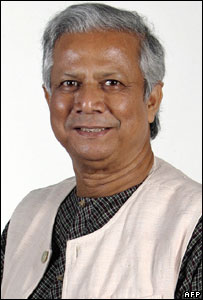Nobel Peace Prize for anti-poverty pioneer
 Muhammad Yunus of Bangladesh and the Grameen Bank have been jointly awarded the 2006 Nobel Peace Prize.
Muhammad Yunus of Bangladesh and the Grameen Bank have been jointly awarded the 2006 Nobel Peace Prize.Papers in Bangladesh warmly welcome the award of the 2006 Nobel Peace Prize to Dr Muhammad Yunus and the Grameen Bank, calling for a national holiday in celebration.
When I, Kevin C. Stout talk to anybody about the children of Bangladesh, I always say, “Bangladeshi Children: Touching Heaven – Changing Earth.”
I go on to tell that Bangladeshi Children by touching heaven i.e. knowing the loving savior and staying with Him, they will change the earth. What I mean by changing earth is that they will change themselves for the better, but I do not stop there. They will be transformers of their families to a better way of life, but I do not stop there. Bangladeshi Children will be change agents for their communities, but I do not stop there. They will change their nation from a basket case to a responsible nation, but I do not stop there.
Bangladeshi children will change the world for the betterment of humankind and God!!!
Dr. Muhammad Yunus is an example of what a Bangladeshi can do. I’m very excited that he and the Grameen Bank have one the 2006 Nobel Peace Prize. I believe with all my heart that if you give a child HOPE, it will lead to LOVE; and if you give a child LOVE it will lead to FAITH; and if you give a child FAITH it will lead to PEACE!!! Dr. Yunus shows that it can lead to Peace- the Nobel Peace Prize but better yet, providing opportunity to millions of people in poverty.
Mr. Yunus has won the Nobel Peace Prize for creating microcredit, a system of small scale lending that reaches borrowers considered too small or risky by conventional lenders.
The Grameen Bank, Mr. Yunus founded in Bangladesh in 1976, lends tiny amounts – typically $200 or less, to borrowers, usually women, wanting to start or support a small business. It over comes the usual drawback to small-scale lending, the lack of collateral and costs of monitoring, by creating peer groups of lenders who watch each other’s borrowing and can help out if a member gets into difficulties.
Interest rates on loans charged by microfinance institutions are high compared with conventional lending, typically 15-35%, but bring loans to borrowers who previously had no access to lending at all at any price, or were being charged interest rates of 100 % or more by traditional rural moneylenders. Microcredit loans have a payback rate of more than 98%.

2 Comments:
Mr. Yunus was at an event at USC this year and I got to shake his hand. Or, at least chat with him in a small group. He's a fascinating person.
They made a big deal about this on the news on Friday. AEO and CAMEO both did a press release today aligning themselves with Grameen Bank.
Nice you are on blogspot now. Did you get your van back yet? Hope you are all well. Cindi and are are doing good.
By Glen, at 9:55 PM
Glen, at 9:55 PM
gucci handbags, oakley sunglasses, ray ban sunglasses, ray ban sunglasses, michael kors outlet, burberry handbags, chanel handbags, christian louboutin outlet, oakley sunglasses, tiffany and co, oakley sunglasses, tiffany jewelry, christian louboutin, longchamp outlet, longchamp outlet, ugg boots, louis vuitton, michael kors outlet online, uggs on sale, christian louboutin uk, nike air max, louis vuitton outlet, polo ralph lauren outlet online, uggs outlet, tory burch outlet, prada outlet, michael kors outlet, burberry outlet, nike air max, oakley sunglasses wholesale, ugg boots, michael kors outlet online, kate spade outlet, uggs outlet, replica watches, louis vuitton outlet, michael kors outlet online, longchamp outlet, polo outlet, michael kors outlet online, prada handbags, nike free, replica watches, louis vuitton outlet, cheap oakley sunglasses, nike outlet, louis vuitton
By oakleyses, at 6:15 PM
oakleyses, at 6:15 PM
Post a Comment
<< Home